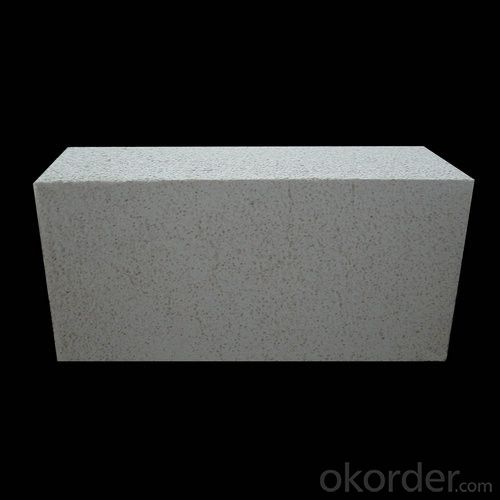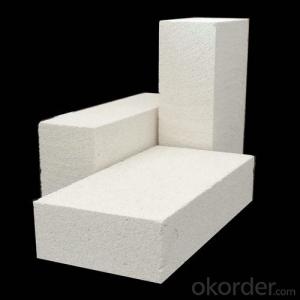High Alumina Insulating Firebrick for Sale
- Loading Port:
- Shanghai
- Payment Terms:
- TT OR LC
- Min Order Qty:
- 1 m.t.
- Supply Capability:
- 1000000 m.t./month
OKorder Service Pledge
OKorder Financial Service
You Might Also Like
Features:This product used super alumina as mainly raw material,adopted the burning weight-loss method to produce
with proper admixture.
Application:Widely used in metallurgy,machinery,ceramic,chemical industry and various furnace lining(Don't suffer the meltwater eroding),and it is an ideal energy-saving product.Using temperature below 1400°C.
Item | Properties | ||||
LTL-0.6 | LTL-0.8 | LTL-1.0 | LTL-1.2 | ||
Bulk density,g/cm3 | 0.6 | 0.8 | 1.0 | 1.2 | |
Cold Crushing strength MPa | 2.0 | 3.98 | 4.98 | 5.98 | |
Permanent linear change,2%(°C×h) | 1350×12 | 1400×12 | 1400×12 | 1400×12 | |
Coefficient of thermal conductivity w/m.k(350±25°C) | 0.25 | 0.29 | 0.35 | 0.45 | |
Fe2O3% | 1.8 | 1.8 | 1.8 | 1.8 | |
AL2O3% | 50 | 50 | 55 | 55 | |
Application | All industrial furnace | ||||

Application of Insulating Firebricks
CMAX insulating firebricks can be used as a hot face lining directly exposed to the heat or as a backup insulation layer in iron and steel mills, non-ferrous foundries, petrochemical, ceramic, glass.
FAQ
Q1: How do you control the products quality?
A1: With strict quality control system throughout the materials selection and production process, our refractory and ceramic fiber products quality is effectively controlled to meet customer requirements.
From the raw materials selecting, our quality control begin. The quality certificates of raw materials are required and each batch will be tested before using. During production, the quality control are conducted by workers and then each piece will be sorted and examined by quality supervis
Q2: What`s the lead time for my order?
A2: It depends on customers’ requirements and our production schedule. And usually we need 30-60 days for refractory bricks,10-25 days for unshaped refractory materials and 10-20 days for ceramic fiber blankets.
- Q:What is the typical open porosity of an insulating fire brick?
- The typical open porosity of an insulating fire brick can vary depending on the specific type and manufacturer. However, on average, insulating fire bricks have an open porosity ranging from 45% to 70%. This means that approximately 45% to 70% of the volume of the brick is made up of interconnected voids or pores. The open porosity is an important characteristic of insulating fire bricks as it directly affects their thermal insulation properties. The higher the open porosity, the better the insulating capabilities of the brick, as the voids act as barriers to heat transfer. Insulating fire bricks with lower open porosity are often denser and more durable, but they may have reduced thermal insulation properties.
- Q:Do insulating fire bricks affect the overall aesthetics of a structure?
- Insulating fire bricks do not significantly impact the overall aesthetics of a structure since they are typically hidden within the walls or used in areas where their appearance is not prominently visible.
- Q:Can insulating fire bricks be used in the construction of pottery molds?
- Insulating fire bricks are indeed applicable for the construction of pottery molds. Crafted from lightweight refractory materials, these bricks possess exceptional heat insulation qualities. Specifically engineered for high-temperature applications like pottery kilns, they offer a range of benefits. When constructing pottery molds, it is imperative to utilize materials that can endure the kiln's intense heat. Insulating fire bricks can withstand temperatures of up to 3000°F (1650°C), rendering them ideal for pottery mold construction. They provide insulation to prevent heat dissipation and maintain consistent temperatures within the kiln, crucial for achieving the desired firing results. Moreover, insulating fire bricks can be conveniently shaped and cut to suit the designated mold design. Their lightweight nature also simplifies handling during the mold construction process. Additionally, the insulating properties of these bricks curtail energy consumption by preventing excessive heat loss, making them a cost-effective choice in the long term. All in all, insulating fire bricks prove to be a fitting option for constructing pottery molds due to their capacity to withstand high temperatures, offer insulation, and be easily molded to meet specific design requirements.
- Q:Are insulating fire bricks resistant to abrasion or erosion?
- Yes, insulating fire bricks are resistant to both abrasion and erosion.
- Q:Can insulating fire bricks be used for insulation in sewage treatment plants?
- Yes, insulating fire bricks can be used for insulation in sewage treatment plants. Insulating fire bricks are specifically designed to withstand high temperatures and provide excellent insulation, making them suitable for use in environments where heat and moisture are present, such as sewage treatment plants. These bricks have low thermal conductivity, which helps to reduce heat loss and increase energy efficiency in the treatment process. Additionally, their resistance to chemicals and moisture makes them ideal for withstanding the corrosive environment found in sewage treatment plants. Therefore, insulating fire bricks can effectively provide insulation in sewage treatment plants, helping to maintain optimum operating temperatures and improve overall efficiency.
- Q:Are insulating fire bricks resistant to alkali attack?
- Yes, insulating fire bricks are generally resistant to alkali attack. These bricks are made from high-temperature refractory materials and are designed to withstand extreme temperatures and chemical environments. Alkalis are known to corrode and degrade certain materials, but insulating fire bricks are specifically formulated to resist this type of chemical attack. They have a low porosity and dense structure, which helps prevent the penetration of alkalis into the brick's surface. Additionally, the refractory materials used in these bricks have a high melting point and are chemically inert, making them well-suited for applications where alkali exposure is a concern. However, it is important to note that the specific resistance of insulating fire bricks to alkali attack may vary depending on the composition and manufacturing process of the brick, as well as the concentration and duration of alkali exposure. Therefore, it is always recommended to consult with the manufacturer or supplier for detailed information about the resistance of their specific insulating fire bricks to alkali attack.
- Q:Can insulating fire bricks be used in chimney liners?
- Chimney liners can indeed utilize insulating fire bricks. These bricks are specifically designed to endure high temperatures and possess exceptional insulation capabilities. They find frequent use in various settings, such as kilns, furnaces, and fireplaces, where retaining heat is crucial. As chimney liners, insulating fire bricks serve a dual purpose. They shield the chimney walls from the intense heat produced by the fire and minimize heat dissipation. These benefits enhance the chimney's efficiency and mitigate the likelihood of harm to the adjacent structure. Nevertheless, it is imperative to seek guidance from a professional chimney technician or engineer to ensure that the chosen insulating fire brick type is appropriate for the desired application and complies with all pertinent safety regulations and building codes.
- Q:Can insulating fire bricks be used for insulation in flues?
- Insulating fire bricks are specifically designed for high-temperature applications and are commonly used in furnaces, kilns, and other industrial settings. While they are excellent for insulating heat and preventing heat loss in these environments, they are not recommended for use in flues. Flues are subjected to extreme temperatures, corrosive gases, and the potential for soot and creosote buildup. Insulating fire bricks are not designed to withstand these conditions and may deteriorate or crack over time when exposed to the acidic and corrosive gases produced by combustion. For insulation in flues, it is best to use materials that are specifically made for this purpose, such as refractory cement or ceramic fiber insulation. These materials are more resistant to the harsh conditions found in flues and are better suited to provide effective insulation while ensuring the safety and durability of the flue system.
- Q:Can insulating fire bricks be used for insulation in chemical plants?
- Yes, insulating fire bricks can be used for insulation in chemical plants. These bricks are designed to withstand high temperatures and provide excellent thermal insulation, making them suitable for insulating equipment, furnaces, and other structures in chemical plants where heat management is crucial.
- Q:Are insulating fire bricks suitable for use in steel mills?
- Yes, insulating fire bricks are suitable for use in steel mills. Insulating fire bricks have high temperature resistance and excellent thermal insulation properties, making them ideal for lining furnaces and kilns in steel mills. They help to maintain high temperatures while minimizing heat loss, resulting in energy efficiency and cost savings. Additionally, insulating fire bricks also provide protection against thermal shock and chemical corrosion, enhancing the overall durability and longevity of steel mill equipment.
1. Manufacturer Overview |
|
|---|---|
| Location | |
| Year Established | |
| Annual Output Value | |
| Main Markets | |
| Company Certifications | |
2. Manufacturer Certificates |
|
|---|---|
| a) Certification Name | |
| Range | |
| Reference | |
| Validity Period | |
3. Manufacturer Capability |
|
|---|---|
| a)Trade Capacity | |
| Nearest Port | |
| Export Percentage | |
| No.of Employees in Trade Department | |
| Language Spoken: | |
| b)Factory Information | |
| Factory Size: | |
| No. of Production Lines | |
| Contract Manufacturing | |
| Product Price Range | |
Send your message to us
High Alumina Insulating Firebrick for Sale
- Loading Port:
- Shanghai
- Payment Terms:
- TT OR LC
- Min Order Qty:
- 1 m.t.
- Supply Capability:
- 1000000 m.t./month
OKorder Service Pledge
OKorder Financial Service
Similar products
New products
Hot products
Related keywords



























